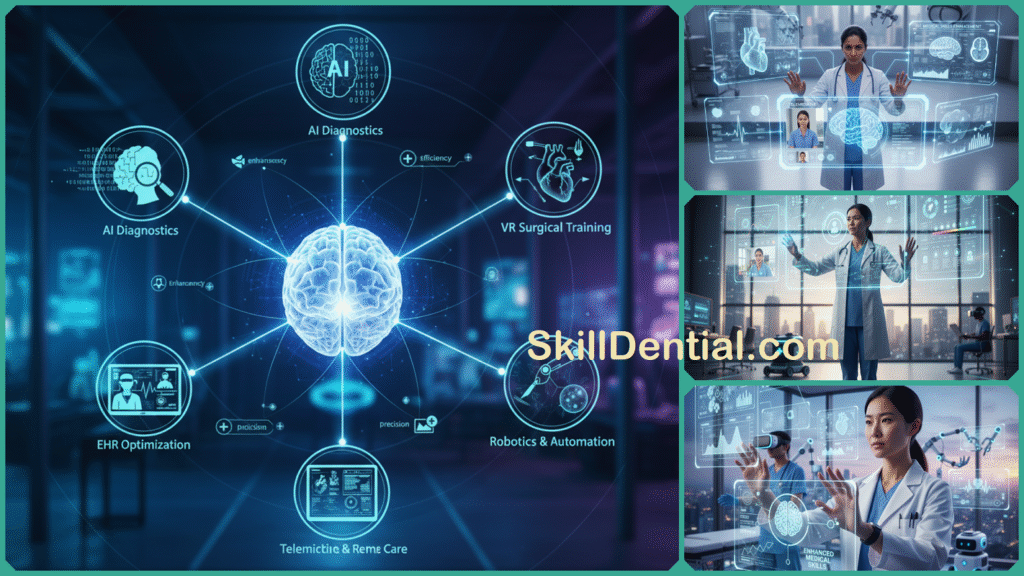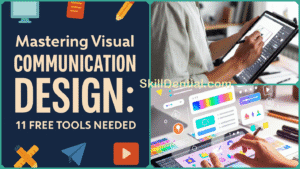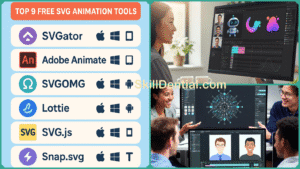The medical field is evolving at an unprecedented and remarkably rapid pace, driven largely by a wide range of transformative and innovative technologies. For healthcare professionals across the spectrum—from physicians and nurses to physician assistants and medical students—the integration of these new and advanced technologies into everyday clinical practice represents not only a significant opportunity for improvement but also an essential and unavoidable necessity in modern healthcare delivery.
Technology provides an extensive range of advanced tools designed to significantly enhance diagnostic accuracy, streamline complex workflows, and completely revolutionize the methods and approaches used in medical training and education.
This blog explores various ways frontline healthcare providers can effectively harness and use cutting-edge technology to significantly elevate their medical skills, enhance patient outcomes, and maintain a competitive edge in an increasingly fast-paced and ever-evolving healthcare environment.

In addition, it thoroughly discusses how healthcare administrators, IT professionals, and educators can play a crucial role in supporting, promoting, and leveraging these technological advances to achieve both operational efficiencies and improved educational opportunities within the healthcare sector.
Key Concepts and Theories of Medical Skills
Medical skills encompass a wide and diverse range of competencies that healthcare professionals need to thoroughly master in order to deliver comprehensive and effective patient care. These essential skills include not only in-depth clinical knowledge and the ability to accurately diagnose and treat various conditions, but also strong patient communication capabilities and the proficiency to perform a variety of medical procedures.
The integration of advanced technology plays a crucial role in significantly enhancing these foundational competencies by providing valuable data-driven insights, offering simulation-based training opportunities, supporting automated clinical decision systems, and enabling innovative remote care platforms that expand the reach and quality of healthcare services.
- Artificial Intelligence (AI) plays a transformative role by employing machine learning algorithms to analyze vast amounts of medical data. This capability assists clinicians with more accurate diagnostics, risk prediction, and personalized treatment plans tailored to individual patients.
- Telemedicine expands healthcare access by enabling virtual consultations and facilitating remote patient monitoring, thus enhancing the clinical reach and convenience for both providers and patients.
- Electronic Health Records (EHRs) digitize and integrate comprehensive patient information, streamlining data access to inform better clinical decisions.
- Virtual Reality (VR) and Augmented Reality (AR) technologies create immersive environments for healthcare professionals to engage in simulated surgical procedures and enhance patient interaction skills within a controlled, risk-free setting.
In addition, technology fosters interactive and student-centered learning experiences across health professions education. VR and AR provide realistic visualizations and practical training scenarios, which improve understanding and skill coordination.
Simulation-based learning replicates clinical cases, allowing repeated practice that builds competence and confidence without risk to patients. E-learning platforms, mobile applications, and online resources complement traditional training by offering accessible, flexible, and tailored educational content.
The integration of these technological tools supports lifelong learning, standardizes clinical training, and enhances both theoretical knowledge and practical skills. It further enables healthcare providers to adapt to evolving healthcare challenges, promoting patient-centered care and improving overall health outcomes.
In Summary
This comprehensive and holistic enhancement of medical skills through the integration of advanced technology not only significantly improves the performance and capabilities of individual clinicians but also fundamentally transforms healthcare delivery systems.
These systems become significantly more efficient, highly effective, and deeply patient-focused, ultimately resulting in much better health outcomes and greatly improved patient experiences across the entire healthcare spectrum.
Current Trends and Developments in Transforming Medical Skills through Technology
In an industry as fast-paced and constantly evolving as healthcare, standing still is simply not an option if we want to stay relevant and effective. We must take deep dives into the must-know advancements that are actively and rapidly redefining clinical practice today—from the significant rise of AI in diagnostics that is transforming how diseases are detected, to the explosive growth of telemedicine and remote patient monitoring technologies that are reshaping patient care beyond traditional settings.
Gaining a thorough understanding of these current and emerging trends is the crucial first step toward effectively future-proofing your own medical expertise, ensuring you remain at the forefront of innovation in healthcare.
AI-Powered Diagnostics and Treatment
Artificial Intelligence (AI) has rapidly evolved into a fundamental cornerstone in the field of modern medical diagnostics, playing an increasingly vital role in healthcare. Today, advanced AI systems are routinely employed to interpret a wide range of medical images, including complex MRI and CT scans.
These AI-driven technologies analyze imaging data with a level of accuracy and precision that frequently exceeds the diagnostic capabilities of even highly experienced human specialists, thereby enhancing the overall quality and efficiency of patient care.
These AI tools use computer vision and deep learning to detect subtle abnormalities and quantify disease markers such as tumor size or density, providing valuable second opinions and prioritizing urgent cases to improve patient outcomes. AI also enables predictive analytics, analyzing vast patient data to identify those at risk for chronic conditions, allowing clinicians to intervene proactively and reduce hospital readmissions.
Moreover, AI tailors drug dosages and treatment plans to an individual’s unique profile, advancing personalized medicine and maximizing therapeutic effectiveness. By 2025, over 70% of large hospital systems globally will deploy AI-based tools across radiology, pathology, cardiology, and emergency triage, marking a shift from experimental use to essential clinical infrastructure.
Telemedicine and Remote Patient Monitoring
Telemedicine platforms have expanded healthcare accessibility by enabling virtual consultations, which are critical for patients in remote or underserved regions. This has helped reduce clinic overcrowding while facilitating continuous care.
Additionally, wearable devices and Internet of Things (IoT)-enabled sensors monitor vital signs around the clock, alerting healthcare providers in real-time to potential deteriorations. Such continuous remote monitoring supports timely interventions and chronic disease management, improving patient outcomes and operational efficiency across healthcare systems.
Electronic Health Records (EHRs) and Clinical Decision Support
EHR systems now serve as centralized repositories housing patient histories, lab results, and medication records accessible by the entire care team. Advanced EHR platforms integrate AI-powered clinical decision support, offering actionable insights such as potential diagnoses, drug interactions, and personalized treatment recommendations based on comprehensive data analysis.
By significantly reducing the need for manual documentation and greatly enhancing the accuracy and reliability of data, these advanced systems effectively streamline complex workflows and provide robust support for evidence-based clinical decision-making processes.
Virtual Reality (VR) and Augmented Reality (AR) in Training
VR and AR technologies are revolutionizing medical education and skills training by creating immersive, interactive environments that replicate surgical procedures, emergency responses, and patient communication scenarios.
These simulations allow healthcare professionals to hone their skills safely without risk to patients. Research supports that VR training significantly improves operative skills and accelerates learning curves in surgical residents, making it a vital tool in clinical competence development.
Robotics and Automation in Surgery and Care
Robotic-assisted surgery has enhanced precision, reduced invasiveness, and improved recovery times in many procedures. Beyond the operating room, automation extends to patient monitoring devices, medication adherence systems, and even social robotics designed to provide emotional support and companionship.
These advanced technologies significantly augment clinical care by substantially increasing accuracy, minimizing the likelihood of human error, and greatly enhancing the overall patient experience throughout the treatment process.
In Summary
These emerging trends collectively illustrate a significant and ongoing shift towards a more technologically integrated and interconnected healthcare system. In this new landscape, advanced tools such as artificial intelligence (AI), telemedicine, virtual reality (VR), and robotics play a crucial role not only in transforming traditional medical skills but also in substantially improving overall efficiency, accuracy, and patient-centered care.
Healthcare professionals who proactively embrace and incorporate these cutting-edge innovations into their daily practice are far better equipped to deliver superior clinical outcomes. Additionally, they are more capable of adapting successfully to the rapidly evolving demands and complexities of modern medicine, ultimately enhancing the quality of care provided to patients.
Action Plan for Healthcare Professionals to Transform Medical Skills through Technology
Moving beyond the latest trends and theoretical concepts, we will provide a concrete blueprint that you can apply immediately and with confidence. These 6 carefully crafted steps serve as a clear and actionable roadmap, specifically designed to help you strategically incorporate the most advanced and innovative technology into your everyday workflow.
By following this plan, you will ensure that your professional expertise not only keeps up with the rapidly evolving digital landscape but also takes a leading role in driving the digital transformation of contemporary medicine.
Step 1: Upskill with Technology Training
Healthcare professionals should begin by enrolling in specialized training programs focused on AI applications in diagnostics, telemedicine best practices, and optimizing Electronic Health Records (EHRs). Many reputable institutions now offer online or hybrid courses tailored to busy medical practitioners, including AI-enabled skills acceleration programs that personalize learning paths using predictive analytics.
Virtual simulation-based clinical training is also a key element to enhance practical skills under real-life scenarios safely. Leading courses are available on platforms like Coursera (Stanford, MIT), HIMSS, and specialized healthcare IT bootcamps that cover essential skills like telehealth, healthcare technology management, cybersecurity, and data literacy.
Step 2: Integrate Telemedicine into Practice
Start by offering virtual consultations primarily for patient follow-ups and chronic disease management. Telemedicine can be scaled gradually, beginning with simple video platforms and expanding to include remote patient monitoring with wearable devices.
Engage patients actively in self-management through education and technology tools to improve compliance and outcomes. Hospitals with successful telehealth programs emphasize strong implementation strategies balancing clinical, legal, and operational considerations.
Step 3: Utilize AI Tools
Adopt AI-powered platforms approved by regulatory bodies to support diagnostics and treatment planning. Use AI tools as clinical decision support rather than replacements, allowing you to enhance diagnostic accuracy and optimize personalized treatment regimens.
Ongoing and continuous training on various AI tools, combined with the provision of active and constructive feedback to software developers, has the potential to significantly enhance both the overall performance and the clinical relevance of these technologies. This iterative process ensures that AI systems are constantly refined and aligned with practical healthcare needs.
Step 4: Leverage VR/AR for Continued Skill Development
Explore virtual reality (VR) and augmented reality (AR) modules for complex procedural practice and patient communication training. These immersive technologies are especially valuable for surgical residents, emergency response teams, and allied health professionals to build competence in a risk-free environment.
Virtual reality simulation programs have been demonstrated through multiple studies to significantly accelerate the learning process and enhance the development of operative skills. These advanced simulation tools provide immersive, hands-on experiences that allow learners to practice and refine their techniques in a risk-free environment.
As a result, users are able to gain proficiency much more quickly and with significantly greater confidence, which ultimately leads to a marked improvement in their overall performance when faced with real-world operative scenarios and challenges.
Step 5: Optimize EHR Use
Maximize EHR system features such as automated alerts, clinical decision support integration, and interoperability with other clinical platforms. This reduces administrative burden, decreases errors, and ensures accurate, timely patient data access.
Actively participate in ongoing electronic health record (EHR) optimization efforts within your healthcare institution to customize and adapt the system functionalities specifically to align with the unique clinical workflows. This involvement helps ensure that the EHR supports healthcare providers effectively and enhances overall patient care processes.
Step 6: Advocate and Collaborate
Engage hospital IT teams, administrators, and technology vendors to advocate for investments that directly support clinical practice improvements. Collaborate by participating in pilot projects, beta testing new tools, and providing feedback to ensure technology solutions align with frontline clinical needs.
Strongly advocate for ongoing, continuous staff training programs and comprehensive quality improvement initiatives that are specifically focused on the latest advancements and practical applications of technology.
Encourage the development of a culture where employees are regularly updated and skilled in new technological tools, ensuring they remain proficient and confident in using these innovations to enhance overall performance and service delivery. Emphasize the importance of integrating technology-focused training as a core component of professional development to drive consistent quality improvements throughout the organization.
In Summary
By following this comprehensive and structured action plan, healthcare professionals are empowered to effectively harness and utilize transformative technologies. This approach not only enhances their medical skills significantly but also leads to substantial improvements in the overall quality of patient care.
Additionally, it equips them with the essential confidence and adaptability skills needed to successfully navigate and thrive amidst the rapidly evolving and ever-changing future landscapes of healthcare.
Benefits of Transformation in Medical Skills through Technology
Transformation isn’t solely about adopting new tools—it’s fundamentally about achieving significantly better outcomes. Before we dive into the detailed “how,” let’s first take a closer look at the powerful, measurable benefits that modernized skills can bring to both patient care and your professional efficiency in today’s fast-evolving digital era.
These enhanced capabilities not only improve the quality of care provided but also streamline workflows, making your daily tasks more effective and impactful.
- Enhanced Diagnostic Accuracy: AI-powered diagnostic tools significantly improve the detection of subtle pathologies beyond the capabilities of the human eye. These technologies use advanced machine learning algorithms to analyze medical images and patient data, reducing diagnostic errors and enabling earlier disease detection—critical factors that can improve patient prognosis and tailor personalized treatment plans.
- Increased Efficiency: Automation of routine administrative tasks such as documentation, scheduling, and data entry helps reduce clinician burnout and frees up valuable time to focus on patient care. AI-enabled clinical decision support also expedites diagnostic and treatment processes, optimizing workflows and improving care delivery without increasing workload.
- Improved Patient Access: Telemedicine has transformed access to healthcare services by overcoming geographic, mobility, and socioeconomic barriers. Studies demonstrate that telemedicine reduces travel burdens, improves access to specialists, and lowers no-show rates. For example, telehealth has significantly enhanced chronic disease management (e.g., diabetes care) by increasing patient engagement and clinical outcomes. Remote consultations have proven especially critical in underserved and rural areas, enabling timely, equitable, and continuous care.
- Better Clinical Competence: Simulation technologies such as Virtual Reality (VR) and Augmented Reality (AR) offer immersive training environments that strengthen procedural skills and improve communication with patients. These tools accelerate learning curves in surgical and emergency training, enhance retention of complex skills, and provide risk-free, repeatable practice opportunities.
- Data-Driven Decisions: Integrated Electronic Health Records (EHRs) combined with AI analysis provide clinicians with comprehensive, real-time insights for making informed decisions. This improves care coordination, medication safety, and treatment personalization, fostering a holistic approach to patient health management.
FAQs
Is technology replacing medical professionals?
Technology is specifically designed to augment and significantly enhance the clinical skills of healthcare professionals, rather than to replace them entirely. The critical elements of human judgment, empathy, and meaningful patient interaction continue to be irreplaceable and essential components of high-quality medical care, ensuring that the personal touch remains at the heart of healthcare delivery.
How can I start using AI in my daily practice?
Begin by incorporating advanced AI tools that provide clinical decision support, specifically those validated for use in diagnostics, risk stratification, or treatment planning. These tools have been rigorously tested to ensure accuracy and reliability in clinical settings. It is crucial to pair the use of these AI systems with comprehensive and ongoing training programs for healthcare professionals. This combination will help maximize the benefits, improve clinical outcomes, and build confidence in utilizing AI technology effectively within medical practice.
Are telemedicine consultations as effective as in-person visits?
For many conditions, particularly follow-ups and chronic disease management, telemedicine is as effective as in-person care. Studies show telemedicine reduces patient travel and barriers while maintaining comparable safety and outcomes. Some conditions and exams still necessitate face-to-face visits, with telemedicine facilitating timely referrals when needed.
What VR tools are available for medical training?
Several platforms, such as PrecisionOS, offer VR surgical simulators and clinical scenario training modules. These technologies provide immersive, risk-free environments that have been shown to improve skills acquisition, especially in surgery and emergency care.
How can technology reduce burnout for healthcare workers?
Automation of routine documentation, scheduling, and patient monitoring reduces administrative burdens. This shift allows clinicians to spend more time on direct patient care, lessening stress and burnout while improving job satisfaction.
In Conclusion
The integration of advanced technology into medical practice is no longer optional—it is essential. Healthcare professionals who embrace AI, telemedicine, EHR optimization, and VR training stand to gain improved efficacy, diagnostic accuracy, and patient outcomes. These tools allow clinicians to work smarter, not harder, preserving time and energy for the human-centered aspects of care.
Furthermore, technology provides a bridge for future-ready training, enabling continuous skill development in a fast-evolving field. By following a structured action plan to learn, adopt, and advocate for clinical technologies, medical professionals can transform their skills and sustain excellence in a digital healthcare era.
For healthcare leaders and educators, understanding these technologies’ impact supports better workforce preparation and service delivery innovation. As the medical community collaborates with technologists and policymakers, a patient-centered, effective, and equitable healthcare system is achievable. Embrace the tech transformation journey today to enrich clinical practice for tomorrow’s healthcare.
Discover more from SkillDential
Subscribe to get the latest posts sent to your email.


